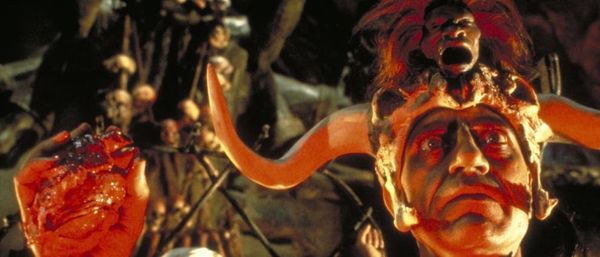Eye For Film >> Movies >> Indiana Jones And The Temple Of Doom (1984) Film Review
Indiana Jones And The Temple Of Doom
Reviewed by: Jennie Kermode

Missing children enslaved in mines. Sacred stones stolen for use in a grotesque ceremony. Human sacrifice. Terrible dinner party etiquette. A screaming nightclub singer, a street kid with a taste for adventure, and a familiar archaeologist with a style of research all his own. It's Indiana Jones alright, and we're in for quite a ride.
This second part of the Indiana Jones trilogy is undoubtedly its weakest link, yet it contains a number of classic scenes and some first class thrills and spills which will appeal to audiences of all ages. Following very much in the Saturday matinee tradition, it has glorious fun with its gruesome temple scenery and with fond clichés like the rope bridge scene and the heroes running away from water in a tunnel. It's essentially just one long chase or dungeon quest, and some of its scenes drag on beyond the point where the audience has found better things to do, but there's still a great deal to enjoy here.

Temple Of Doom inevitably suffers from being compared to the other Indiana Jones films. Seen in its own right, it stands up pretty well, but its directionless cultists will never be able to compete with the others' scheming Nazis and its snivelling heroine is no match for Karen Allen's charismatic Marion.
Where it does succeed is with Amrish Puri's powerful performance as Mola Ram, ripping still-beating hearts from his victims' chests, an unforgettable screen villain. Puri is more than a match for Harrison Ford as the bold hero, and there are some great scenes between them amid the fairground-style frolics and the seemingly endless fist fights. Ke Huy Quan also works well as Indy's sidekick Short Round - he's endearing without being sentimental and his resourcefulness makes him a hero in his own right, someone whom child viewers will easily identify with.
Temple of Doom has been heavily criticised for its racist undertones, with the white stranger (ultimately backed up by colonials) saving the poor helpless Indians from devotees of a supposedly primitive religion. Its portrayal of women is also problematic, with Willie so weak-willed that it's never really clear why she was there in the first place. This is perhaps justified somewhat if we look at the film not as an Eighties movie but as an adaptation of something which has its roots very much in the Thirties. To its credit, it's never self-conscious about its politics, it doesn't patronise viewers with attempts to justify itself, and it stays true to the values of its various characters, with Indiana several times demonstrating the advantages of a cosmopolitan attitude. Nevertheless, its infamous banquet scene really could do with an insert beforehand in which kitchen staff discuss the fun they're going to have inventing things with which to troll the white people.
Essential viewing if you've enjoyed the rest of the series, this may not be the best that Lucas and Spielberg have to offer, but it contains some truly unmissable moments.
Reviewed on: 26 Jun 2007


















